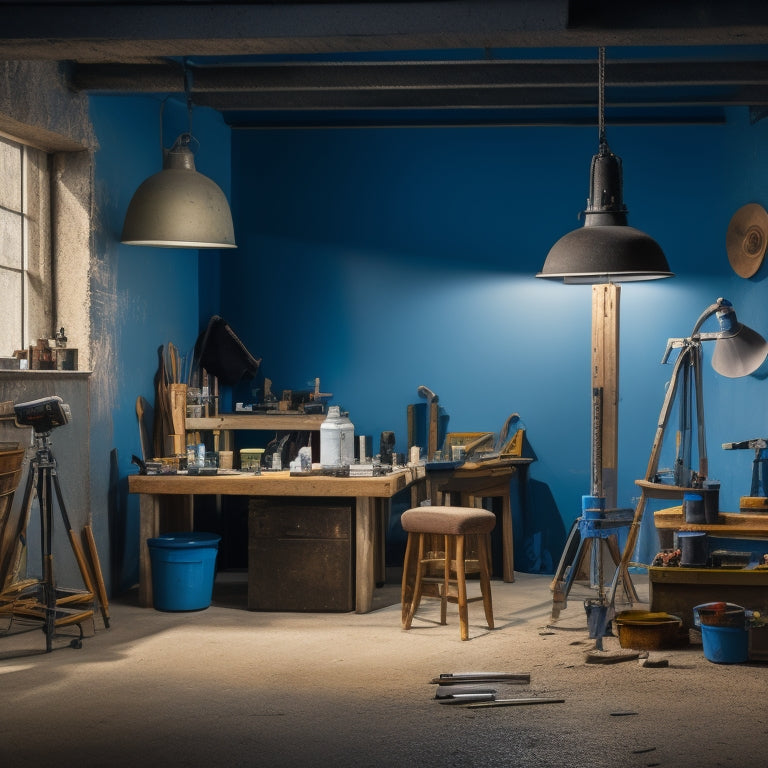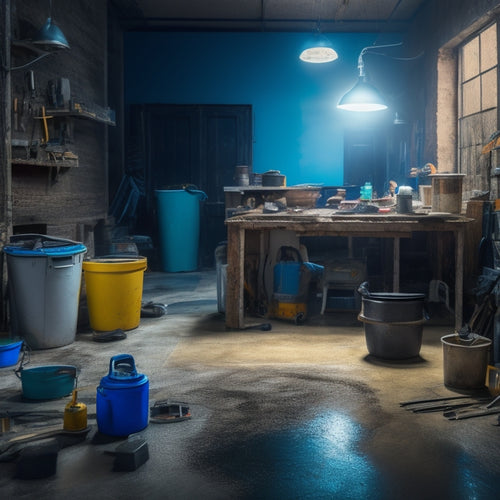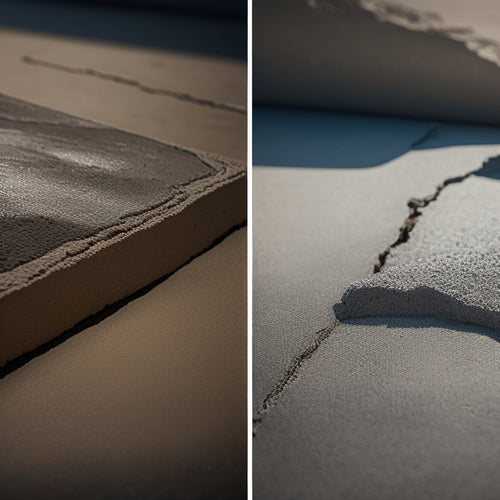
7 Best Tools for Painting Concrete Walls Smoothly
Share
To achieve a smooth, even paint job on concrete walls, you'll need the right tools for surface preparation and efficient application. Start with a power washer to clean the surface, followed by a concrete etcher to guarantee better adhesion. Next, use a sanding block to smoothen out imperfections and a putty knife to fill cracks. For painting, invest in a high-pressure sprayer for efficient coating and a roller extension pole for a smooth finish. Don't forget to protect your floors with drop cloths. With these seven essential tools, you'll be well on your way to a professional-looking finish - and there's more to learn about mastering each step of the process.
Key Takeaways
- A power washer ensures a clean surface by removing dirt, grime, and old adhesive residue, guaranteeing a smooth paint application.
- A concrete etcher creates a rough texture for better paint adhesion, with options like muriatic acid, TSP, and sodium bicarbonate available.
- Sanding blocks with coarse-grit sandpaper (80-100) remove imperfections and old adhesives, followed by finer grits (120-150) for a smooth finish.
- A putty knife fills cracks with precision, using flexible blades and proper techniques for small and large cracks, and adhering to manufacturer's instructions.
- High-pressure sprayers, roller extension poles, and drop cloths are essential for efficient and smooth painting, with adjustable options for optimal performance.
Power Washer for Surface Cleaning
Before applying a fresh coat of paint, it's essential to verify the concrete wall surface is free from dirt, grime, and old adhesive residue.
You'll need to employ effective surface preparation techniques to guarantee a strong bond between the paint and the wall. A power washer is an excellent tool for this task. With its high-pressure water jet, you can blast away dirt, grime, and old adhesive residue, leaving the surface clean and ready for painting.
When using a power washer, you'll want to adjust the pressure setting according to the wall's condition. For heavily soiled surfaces, you may need to use a higher pressure setting, while lighter cleaning tasks can be accomplished with a lower setting.
Additionally, you can use cleaning agents specifically designed for concrete surfaces to enhance the cleaning process. By combining the power washer with the right cleaning agents, you'll be able to achieve a thorough cleaning and guarantee a smooth, even paint application.
Concrete Etcher for Better Adhesion
After cleaning the concrete wall surface, you'll need to etch it to create a rough texture for the paint to adhere to. This vital step in surface preparation techniques guarantees a strong bond between the paint and the concrete.
You can choose from various etching solutions, each with its own strengths and weaknesses. Muriatic acid, for instance, is a popular choice due to its effectiveness and affordability. However, it can be hazardous to work with and requires careful handling.
Alternative etching solutions, such as trisodium phosphate (TSP) or sodium bicarbonate, offer a safer and more environmentally friendly option. When selecting an etcher, consider factors like the level of etching required, the type of concrete, and the desired finish. A thorough etching solutions comparison will help you make an informed decision.
High-Pressure Sprayer for Efficient Coating
You'll get the most out of your high-pressure sprayer when you can control the spray pattern to fit your specific concrete wall project.
Look for a sprayer that allows you to adjust the fan tip, giving you a range of spray widths and angles to work with.
Additionally, having pressure adjustment options will enable you to fine-tune the output to achieve the perfect coating thickness.
Spray Pattern Control
Precision is key when it comes to achieving an even, professional-looking finish on concrete walls, and that's exactly what a high-pressure sprayer with spray pattern control delivers.
You get to adjust the spray fan pattern, which is vital for coating concrete walls efficiently. With spray pattern control, you can switch between different spray nozzle types, such as wide fan, narrow fan, or circular patterns, depending on the specific requirements of your project. This level of control guarantees that you can achieve an even coat, even on irregularly shaped surfaces.
When working with different paint types, you'll appreciate the ability to make paint viscosity adjustments. Thicker paints require a larger nozzle orifice, while thinner paints need a smaller one.
By adjusting the spray pattern and nozzle size, you can optimize the flow rate and pressure to suit the paint's viscosity. This results in a smooth, even finish that's free of streaks and blotches.
With spray pattern control, you'll save time, reduce waste, and achieve a professional-looking finish that meets your high standards.
Pressure Adjustment Options
How much pressure is ideal for achieving an efficient coating on concrete walls? The answer lies in the pressure adjustment options of your high-pressure sprayer. You'll want to adjust the pressure to guarantee an even, smooth coat without wasting paint or compromising adhesion.
| Pressure Range (psi) | Spray Nozzle Size (in) |
|---|---|
| 1000-1500 | 0.015-0.021 |
| 1500-2000 | 0.021-0.025 |
| 2000-2500 | 0.025-0.031 |
| 2500-3000 | 0.031-0.035 |
| 3000-3500 | 0.035-0.039 |
Using a pressure gauge, you can fine-tune the pressure to match your specific painting needs. Keep in mind that higher pressures can lead to over-spray and wastage, while lower pressures may result in an uneven coat. By adjusting the pressure and selecting the right spray nozzle size, you'll achieve a smooth, efficient coating on your concrete walls.
Roller Extension Poles for Smooth Finish
When selecting a roller extension pole for a smooth finish, you'll want to take into account the pole material, as it affects durability and weight.
Fiberglass, aluminum, and stainless steel poles each have their advantages, and choosing the right one depends on your specific needs.
Additionally, look for adjustable length options to guarantee you can reach all areas of the concrete wall without straining.
Pole Material Matters
You're reaching for the perfect roller extension pole to guarantee a smooth finish on your concrete walls. When selecting the ideal pole, the pole material matters greatly.
Fiberglass and aluminum are two common materials used for extension poles. Fiberglass poles are lightweight, making them easy to maneuver, especially when working at high pole heights. However, they can be prone to flexing, which may affect the smoothness of your finish.
Aluminum poles, on the other hand, are sturdier and less likely to flex, providing a more consistent application of paint. They can be heavier, but their added strength assures a smooth finish.
Consider a hybrid option that combines the benefits of both materials for peak performance. Regardless of the material you choose, confirm it's durable and able to withstand the weight of your roller and paint.
A high-quality pole material will help you achieve a professional-looking finish on your concrete walls.
Adjustable Length Options
Selecting a roller extension pole with adjustable length options guarantees you can reach every area of your concrete wall without sacrificing control or smoothness. This feature is vital for achieving a professional-looking finish, as it allows you to adapt to varying wall heights and angles.
With an adjustable roller extension pole, you can effortlessly switch between painting high ceilings and low-lying areas, securing a consistent coat.
Adjustable rollers offer more than just flexibility in length; they also provide versatility in attachment options. You can easily swap out rollers with different nap lengths, fiber types, or even switch to a brush attachment for cutting in or painting corners.
This adaptability enables you to tackle complex concrete wall projects with ease, making it an essential feature for any serious painter.
When shopping for a roller extension pole, look for one with a durable, locking mechanism that securely holds the pole at your desired length. This will guarantee you maintain control and precision throughout the painting process.
With an adjustable length option, you'll be able to tackle even the most challenging concrete wall projects with confidence.
Putty Knife for Filling Cracks
Since concrete walls are prone to cracking, filling those cracks is an essential step before painting. You'll need a putty knife to guarantee a smooth finish. This versatile tool is designed for scraping, spreading, and filling, making it perfect for filling cracks.
When selecting a putty knife for filling cracks, consider the type of crack materials you're working with. For smaller cracks, a 1-2 inch putty knife is ideal, while larger cracks may require a 4-6 inch knife. Choose a knife with a flexible blade to conform to the crack's shape, allowing for a more precise fill.
Filling techniques vary depending on the crack's size and location. For smaller cracks, use a putty knife to apply a thin layer of filler, spreading it smoothly and evenly.
For larger cracks, you may need to apply multiple layers, allowing each layer to dry before applying the next. Always follow the manufacturer's instructions for the specific filler you're using.
Sanding Blocks for Smoothening Surface
After filling cracks, guaranteeing a smooth surface is vital for an even paint finish. To achieve this, you'll need to use a sanding block, an essential tool for surface preparation. A sanding block helps to remove any imperfections, old adhesives, or rough patches that may affect paint adhesion.
When selecting a sanding block, choose one with a sturdy construction and a comfortable grip. This will allow you to apply even pressure, guaranteeing a consistent finish. Use a coarse-grit sandpaper (around 80-100) to start, gradually moving to finer grits (120-150) for a higher gloss finish.
Work in sections, sanding in a circular motion to prevent scratches. Mastering sanding techniques takes practice, but it's worth the effort. A well-sanded surface guarantees better paint adhesion, reducing the risk of peeling or flaking.
Drop Cloths for Protecting Floors
Now that you've perfected the art of sanding, it's time to think about protecting your floors from paint spills and stains. A good drop cloth is essential for this task, and you'll want to choose the best dropcloth materials for the job. Look for cloths made from heavy-duty, waterproof materials like canvas or plastic. These will provide a reliable barrier between your floors and any paint that might spill or drip.
When it comes to floor protection techniques, a few simple steps can make all the difference. Start by laying down the drop cloth, making certain to cover the entire area you'll be painting.
Use tape to secure the cloth to the walls or baseboards, guaranteeing a tight seal. You can also use weights or sandbags to hold the cloth in place.
Frequently Asked Questions
Can I Use a Regular Garden Hose Instead of a Power Washer?
You can use a regular garden hose, but it won't provide the same intense cleaning as a power washer, which blasts dirt and grime off surfaces more efficiently, making it a better option for thorough preparation.
How Long Does Concrete Etching Typically Take to Complete?
You'll be pleased to know that concrete etching typically takes around 10-30 minutes to complete, depending on the surface area and etching techniques used, ensuring a smooth concrete surface preparation for your next project.
Is It Necessary to Use a Primer Before Painting Concrete?
When painting concrete, you'll find it's usually necessary to use a primer, as it enhances primer benefits like improved concrete adhesion, ensuring a strong bond between the paint and surface, and reducing the risk of peeling or flaking.
What Is the Recommended Thickness for Applying Concrete Paint?
You're about to begin a concrete painting journey, but first, imagine a layer cake – you're the expert baker, and the perfect slice is 1-2 mils thick. For a smooth finish, you'll need to adjust application techniques based on paint types, ensuring an even, thin coat that's not too rich.
Can I Paint Over Existing Concrete Paint Without Prep Work?
You can't assume existing concrete paint is a suitable base for new paint without prep work, as it may compromise paint adhesion and surface compatibility; always assess the surface's condition and perform necessary prep to guarantee a strong bond.
Conclusion
You've made it through the grueling process of painting concrete walls. Pat yourself on the back, but not too hard, or you'll mess up that fresh coat. Now, go forth and admire your handiwork, but don't get too comfortable – those walls will need a touch-up sooner than you think. Remember, painting concrete is a never-ending battle against cracks, peeling, and fading. But hey, at least you've got the right tools for the fight.
Related Posts
-

Essential Tools for Epoxy Concrete Floor Repair
You'll need a thorough arsenal of specialized tools to guarantee a successful epoxy concrete floor repair. Floor prep...
-

What Tools Ensure Strong Concrete Adhesion at Home
You'll need the right tools to guarantee strong concrete adhesion at home. For surface preparation, use concrete surf...
-

Free Design Tools for Concrete House Planning
You can kick-start your concrete house planning project without breaking the bank, as there are several free design t...


